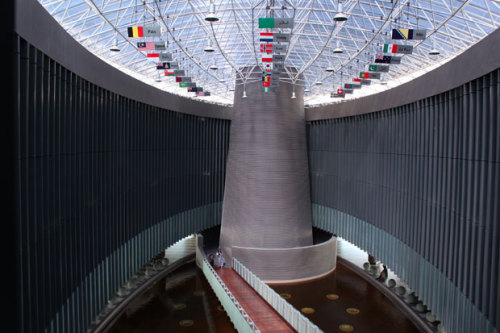
BANDA ACEH – The building is strikingly contemporary in a city where most structures are rather simple and unpretentious. In the middle of Banda Aceh, the capital city of the Province of Aceh in Northern Sumatra, the Tsunami Museum is a tribute to the terrible catastrophe which killed officially 132,000 people –but estimates talk about 220,000 victims- while there was billion of dollars of damage of public and private infrastructure.
The museum gives information about the catastrophe, the help provided by donor countries and private and talk about the resilience of Acehnese to start again. “This is what we want to show above all. The tsunami was a tragedy but we learn from it and we want to convey a message of hope. We in fact think that the tsunami helped Acehnese to turn a disaster into an opportunity for a new life. And at the same time to communicate how to prevent it”, says Rahmadhani, Director for Programming and Planning at Aceh Culture & Tourism Office and Secretary for Aceh Tsunami Museum.
The museum opened in 2009. Conceived by Indonesian architect Ridwan Kamil, it is a rather simple structure stretching over a four-story 2,500 m2 space. A dark corridor at the museum’s entrance with high walls of water recreates the sense of fear and feeling that seized people when the tsunami struck. what people could have experienced when the tsunami struck. The exhibition pays also tribute to traditional architecture of Aceh and the knowledge of older generations. “They knew how to preserve themselves from the tsunami effect. Some villages built in traditional style remained unaffected by the catastrophe”, adds Rahmadhani.
The anniversary will then carry this resilience spirit. Transcending the sadness and the tragedy –most Acehnese lost someone or something in the tsunami- Aceh wants to take the opportunity to convey a message of peace and hope. “Commemorating the tsunami is to look at our future. We first look at the way to develop a resilient community, a society which is prepared and which is able to talk of our experience on the path to recovery to other disaster-prone areas. In that way, the tsunami experience is a positive contribution to human mankind”, adds Rahmadhani.
Aceh Culture and Tourism Office have then encouraged the development of “memory tourism”. A circuit is organised along iconic sites linked to the tsunami. Such as a massive floating power plant ship, which was moved 4 km inland by a giant wave and is now to be visited. Or a boat which ended up on the roof of a house. Spectacular sites but where sadness is not present. “We leave these objects to local community to take care of and to develop. The fact that tourists come to visit help to generate revenues towards locals”, stresses Rahmadhani.
The tsunami had another –if indirect- positive effect. It helped putting a stop of years of civil unrest and fighting between the partisans of the Free Aceh Movement (Gerakin Aceh Merdeka or GAM) and the Indonesian Army sent by the Central Government.The tsunami paved the way to a ceasefire and in July 2005, a peace agreement was signed between Aceh and the Central Government. Since then, Aceh has been enjoying a high degree of autonomy and is concentrating its efforts to rebuild and bring prosperity to its people.
The best testimony to post-tsunami Aceh is to come and enjoy life there. Most visitors might be pleasantly surprised. There is a kind of relaxing atmosphere in the air with gentle smiling people, welcoming faces and a sense of safety which is sometimes lacking in other Asian destinations. Experiencing people dressed in colourful outfits going to Banda Aceh splendid Grand Mosque, enjoying local food delicacies, talking to people in the multiple lively coffee shops, where Acehnese youth gathers, visiting the city and its superb natural surroundings. Aceh is all of this and even more. “Seeing is believing. And believing is loving”, concludes Rahmadhani. He is so right!


